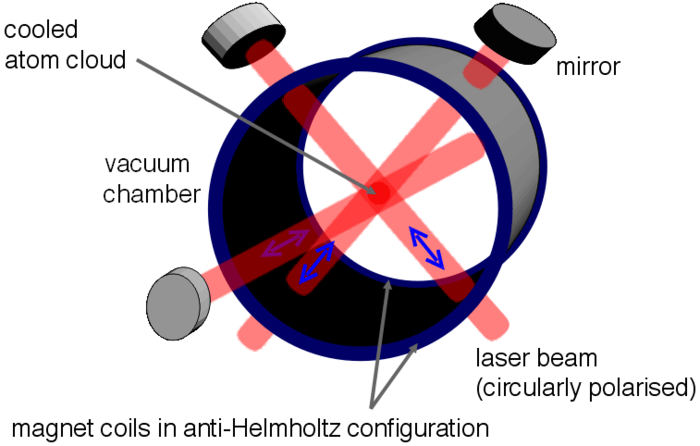New type of ‘ultracold’ molecule ideal for quantum computing
March 14, 2014
Purdue University researchers have created a new type of “ultracold” molecule, using lasers to cool atoms to about one thousandth of degree above absolute zero using lasers and then gluing them together, a technology that might be applied to quantum computing, precise sensors, and advanced simulations.
At these temperatures, atoms are brought to a near standstill, making possible new kinds of chemical interactions that are predominantly quantum mechanical in nature. The process is performed inside of an apparatus called a magneto-optical trap, a system that uses a vacuum chamber, magnetic coils and a series of lasers to cool and trap the atoms.
Other researchers have used the method to create cold molecules out of atoms of other alkali metals, which are relatively easy to turn into ultracold molecules. But two Purdue researchers — Yong P. Chen, an associate professor of physics and electrical and computer engineering and Daniel S. Elliott, a professor of electrical and computer engineering and physics — and their team are the first to achieve the milestone with the alkali metals lithium (Li) and rubidium (Rb).
A molecule optimized for quantum computing
The method is called photoassociation: two atoms are merged using lasers to induce a chemical bond between them, forming a molecule. These molecules may contain two of the same types of atoms — making them homonuclear — or they can contain two different types of atoms, heteronuclear, such as the case with the lithium-rubidium molecules created by the team.
If the molecules are heteronuclear, there is a difference in electric charge between these two atoms and the molecule is said to be polar. This difference in charge is called a dipole moment, which enables interaction between molecules. The greater the dipole moment, the stronger the interaction.
The lithium-rubidium molecule is potentially ideal for various applications, including quantum computing, because it has a significant dipole moment at their ground state, which can enable these molecules to be used as “quantum bits.”
Quantum computers would take advantage of “entanglement.” Instead of only the states of one and zero used in conventional computer processing, there are many possible “entangled quantum states” in between one and zero, dramatically increasing the capacity to process information. Another potential advantage for the lithium-rubidium molecule is that it can be produced in large quantities.
“Lithium rubidium is one of the last bi-alkali molecules to be made cold, and we are the first to do this,” Chen said. “People knew virtually nothing about these molecules.”
Findings are detailed in a research paper in the February issue of the journal Physical Review A.
The research has been funded by Purdue’s Bilsland Dissertation Fellowship, the National Science Foundation, Army Research Office, and more recently by a research incentive grant from Purdue’s Office of Vice President for Research.
Abstract of Physical Review A paper
We report the production of ultracold heteronuclear Li7Rb85 molecules in excited electronic states by photoassociation (PA) of ultracold Li7 and Rb85 atoms. PA is performed in a dual-species Li7-Rb85 magneto-optical trap (MOT) and the PA resonances are detected using trap loss spectroscopy. We identify several strong PA resonances below the Li (2s 2S1/2) + Rb (5p 2P3/2) asymptote and experimentally determine the long range C6 dispersion coefficients. We find a molecule formation rate (PLiRb) of 3.5 × 107 s−1 and a PA rate coefficient (KPA) of 1.3 × 10−10 cm3/s, the highest among heteronuclear bi-alkali-metal molecules. At large PA laser intensity we observe the saturation of the PA rate coefficient (KPA) close to the theoretical value at the unitarity limit.
Abstract of Europhysics Letters paper
We report the production of ultracold 7Li85Rb molecules by photoassociation (PA) below the Li (2s 2S1/2) + Rb(5p 2P1/2) asymptote. We perform PA spectroscopy in a dual-species 7Li-85Rb magneto-optical trap (MOT) and detect the PA resonances using trap loss spectroscopy. We observe several strong PA resonances corresponding to the last few bound states, assign the lines and derive the long-range C6 dispersion coefficients for the Li (2s 2S1/2) + Rb(5p 2P1/2) asymptote. We also report an excited-state molecule formation rate  of
of  and a PA rate coefficient
and a PA rate coefficient  of
of  , which are both among the highest observed for heteronuclear bi-alkali molecules. These suggest that PA is a promising route for the creation of ultracold ground-state LiRb molecules.
, which are both among the highest observed for heteronuclear bi-alkali molecules. These suggest that PA is a promising route for the creation of ultracold ground-state LiRb molecules.
